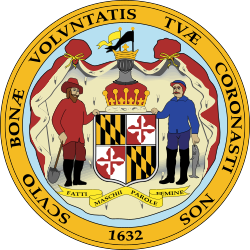William Pinkney
William Pinkney (* 17. März 1764 in Annapolis, Province of Maryland; † 25. Februar 1822 in Washington, D.C.) war ein US-amerikanischer Jurist, Diplomat, US-Senator und Justizminister (Attorney General).
Studium und berufliche Laufbahn
Pinkney absolvierte Studien der Medizin sowie der Rechtswissenschaften. Nach der anwaltlichen Zulassung 1786 war er einige Jahre als Rechtsanwalt im Harford County tätig. Während des Britisch-Amerikanischen Krieges von 1812 diente er als Major in der United States Army. Als solcher wurde er in der Schlacht bei Bladensburg am 24. August 1814 verwundet.
Politische Laufbahn
Abgeordneter und Bürgermeister
Pinkney wurde schon frühzeitig auch politisch aktiv als Mitglied des Verfassungskonvents von Maryland. Von 1786 bis 1792 saß er erstmals im Abgeordnetenhaus von Maryland. 1791 gehörte er für kurze Zeit dem Repräsentantenhaus der Vereinigten Staaten an, wo er den dritten Kongresswahlbezirk von Maryland vertrat.
Nach einer erneuten Mitgliedschaft im Abgeordnetenhaus von Maryland im Jahr 1795 war er von 1795 bis 1800 Bürgermeister von Annapolis. Von 1805 bis 1806 war er Attorney General von Maryland. 1811 wurde Pinkney Mitglied des Senats von Maryland. Nach dem Britisch-Amerikanischen Krieg war er von 1815 bis 1816 wiederum als Vertreter des fünften Kongresswahlbezirks von Maryland Abgeordneter im US-Repräsentantenhaus.
Diplomat, Justizminister und US-Senator
Neben seiner politischen Laufbahn übernahm er auch diplomatische Posten. Von 1806 bis 1807 war er zunächst neben James Monroe Gesandter und danach als dessen Nachfolger von 1808 bis 1811 Bevollmächtigter Gesandter im Vereinigten Königreich.
Am 11. Dezember 1811 berief ihn US-Präsident James Madison als Attorney General in sein Kabinett. Dieses Amt übte er bis zu seiner Ablösung durch Richard Rush am 9. Februar 1814 aus.
Von 1816 bis 1818 übernahm er als Bevollmächtigter Gesandter in Russland wiederum eine Tätigkeit im Diplomatischen Corps. Während dieser Zeit wurde er auch mit einer Sondermission in Neapel betraut.
Zuletzt war Pinkney, der der Demokratisch-Republikanischen Partei angehörte, von 1819 bis zu seinem Tod 1822 US-Senator.
Literatur
- Pinkney, William. In: James Grant Wilson, John Fiske (Hrsg.): Appletons’ Cyclopædia of American Biography. Band 5: Pickering – Sumter. D. Appleton and Company, New York 1888, S. 26 (englisch, Textarchiv – Internet Archive).
- Henry Wheaton: Some account of the life, writings, and speeches of William Pinkney. J. W. Palmer & co. New York, 1826; Textarchiv – Internet Archive
- The Life of William Pinkney. By his nephew The Rev. William Pinkney. D. Appleton and Company, New York 1853; Nachdruck: Da Capo Press, New York 1969; archive.org
- Robert Ireland: The Legal Career of William Pinkney, 1764–1822. Garland, New York 1986
Weblinks
- Biografie im US-Rechtslexikon
- William Pinkney im Biographical Directory of the United States Congress (englisch)
- Biografie auf der Homepage des Justizministeriums
- William Pinkney im Miller Center of Public Affairs der University of Virginia (englisch)
| Personendaten | |
|---|---|
| NAME | Pinkney, William |
| KURZBESCHREIBUNG | US-amerikanischer Politiker, Senator und Justizminister |
| GEBURTSDATUM | 17. März 1764 |
| GEBURTSORT | Annapolis, Maryland |
| STERBEDATUM | 25. Februar 1822 |
| STERBEORT | Washington, D.C. |
Auf dieser Seite verwendete Medien
Autor/Urheber:
Louis Dreka designed the actual seal, first used in 1885 per here. Vectorized from a version in stained glass.
The Seal of the United States Senate, the upper house of the United States Congress. See also the Seal of the United States House of Representatives.
Unofficial seal of the United States House of Representatives, based directly on the Great Seal of the United States. The official seal depicts the House side of the Capitol building,[1] but this is still a commonly seen symbol.
Seal of the United States Department of Justice. The coloration does not quite match the version seen on the Department's home page, but does appear elsewhere on the website.
The origins of the seal are unknown; it was first used in the 19th century as the seal for the Office of the Attorney General (prior to the formation of the Department of Justice) but the exact date is unknown. Even the translation of the Latin motto is murky, a matter of debate between Latin scholars. The Department's currently accepted translation is who prosecutes on behalf of Lady Justice, referring to the Attorney General. The current-day seal dates from 1934, when some (though not all) of the heraldic mistakes on the original were corrected. More information here.








